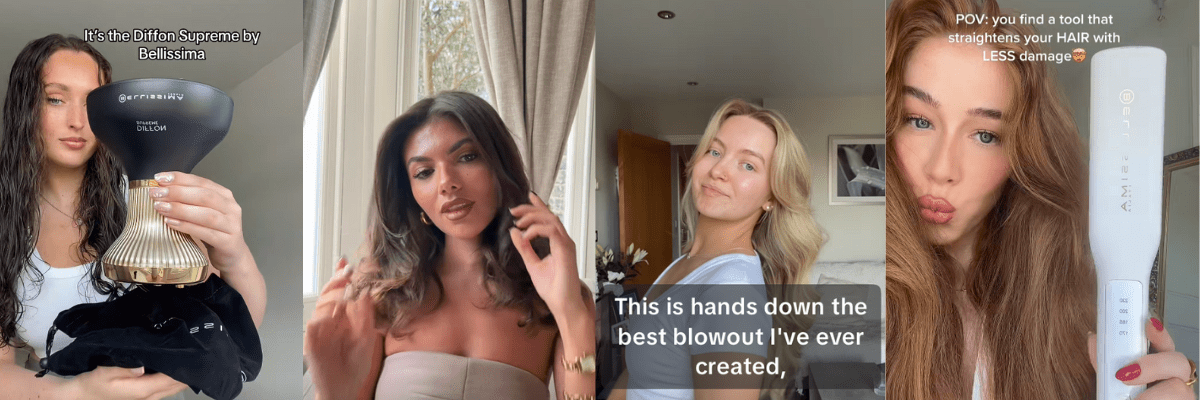Image credit: @by.loren, @samieelishi, @sophiebarkleyy and @isabellakatee on TikTok.
The way we search is changing.
Consumers aren’t just Googling anymore. We’re splitting attention between traditional search engines, visual-first platforms like TikTok and generative AI tools like ChatGPT.
The shift in search behaviour is fragmenting the once-unquestioned dominance of Google. And in its wake, social media platforms like TikTok are requiring their own search engine optimisation (SEO) playbooks.
What is TikTok SEO?
TikTok SEO is the practice of optimising your content so that it becomes more discoverable and visible on TikTok.
The strategic approach improves your chances of showing up in search queries and on the TikTok feed – the For You Page (FYP) – where you’ll have the opportunity to reach a global audience.
And since Google began surfacing TikTok videos in its search results, particularly for TikTok-related queries, TikTok SEO can also improve your chances of appearing in Google’s SERP.
Why is TikTok SEO important?
Google might still dominate the UK search scene, holding 93.37% of the market as of March 2025, but cracks are starting to show. That figure is already down 1.05% since August 2024. And globally, Google’s share dipped below 90% in late 2024 for the first time in nearly a decade.
The shift hasn’t gone unnoticed. The tech giant publicly acknowledged users’ growing preference to search on social platforms like TikTok and Instagram as early as 2022.
Google’s Chief Technologist Prabhakar Raghavan stated, “In our studies, something like almost 40% of young people, when they’re looking for a place for lunch, they don’t go to Google Maps or Search. They go to TikTok or Instagram.”
With over 1.6 billion users worldwide and its own in-app search function, TikTok functions as a visual-first search engine powered by community, trends and real-time relevance.
In fact, Google has adapted its own results to keep up. TikTok videos now surface in Google’s SERPs, often outranking traditional text-based links for queries that reference the platform (e.g., ‘hair diffuser reviews tiktok’). This means TikTok SEO can help your discoverability on TikTok and climb Google’s results.

Image: In this Google search results page for ‘hair diffuser reviews tiktok’, the indexed videos outrank text-based links. Influencer content we produced for our client Bellissima tops the list.
Users want fast, engaging and context-rich answers, and TikTok is perfectly positioned to deliver. Brands that lean into this shift, and optimise their content, will be the ones that benefit the most.
How does TikTok’s algorithm work?
TikTok’s algorithm determines which content is shown in search results and on a user’s FYP.
The algorithm prioritises content that’s relevant and engaging, and rewards creators who keep viewers watching by boosting their visibility.
It does this by evaluating:
- Video information: captions, hashtags, sounds
- User interactions: likes, shares, comments, watch time
- Device and account settings: language, location, device type
Of these, video information and user interactions carry the most weight and are the most controllable.
Device and account settings have less influence on ranking and can’t be directly optimised, though they do help TikTok personalise content delivery on an individual level.
Interestingly, follower count isn’t a ranking factor, which makes TikTok a rare meritocracy in the social space.
The platform has also published an article into how the algorithm works, which you can read here.
How to optimise your content using TikTok SEO
1. Conduct keyword research
Before filming, start with keyword discovery.
Use tools like TikTok’s Creative Centre or keywordtool.io to find platform-specific keywords.
Semrush and Google Keyword Planner are also useful tools to identify high-intent phrases, common queries in your niche and adjacent trends worth tapping into.
The outcome of your research should be a list of keywords to use in your videos along with plenty of content ideas.
2. Optimise text-based video information
Hashtags
Use 3-5 hashtags that include your keywords (e.g., #bestcleanser), broad trending tags (e.g. #fyp, #tiktokmademebuyit) and specific, niche hashtags (e.g. #cleanbeauty) to maximise reach and relevance.
Captions
Include keywords in your captions to help TikTok understand what your video is about and who to show it to.
Captions are also a great opportunity to boost engagement. Add a call-to-action (CTA) to prompt viewers to comment, share or engage. This can link directly to your content to feel more authentic (e.g., ‘Help me pick what to wear in the comments’).
3. Optimise audio-based video information
Trending sounds and songs
Use trending sounds to boost discoverability. Find out exactly what’s trending right now alongside a graph mapping its growth on TikTok’s Creative Centre.
Voiceovers
If you’re using voiceovers, try to include keywords naturally – TikTok is increasingly using AI-driven tools to understand spoken content, which may help with discoverability.
4. Optimise visual video information
Text overlay
Place key phrases on screen in the first 3 seconds. This helps TikTok classify your content and improves watch time.
Effects and filters
Use green screens, trending filters and transitions to boost visual interest. TikTok rewards engaging content with higher placement.
Subtitles
Subtitles are a must for accessibility, and the platform uses them to understand your video’s content and recommend it to users searching for related topics.
5. Optimise for user interactions
Nail the hook
Hook within 1-2 seconds, then deliver value. High average watch time, especially in the first few seconds, is one of TikTok’s most powerful ranking signals.
If users aren’t watching your video all the way through or are dropping off in the first few seconds, your chances of appearing in search or the FYP plummet.
Post consistently and at the right time of day
TikTok favours consistent high-volume content and recommends 1-4 posts every day.
Posting when your followers are online increases the chance of early engagement, which boosts visibility. Leverage TikTok Analytics to identify when your audience is most active, and schedule accordingly.
Reply to comments
Engage with comments as responses are indexed and boost SEO. It’s also worth updating old videos by replying to comments with follow-ups (TikTok loves this content loop).
Want to level up your TikTok presence?
Our team of social media experts create thumb-stopping content that’s algorithm-optimised for results. Get in touch to see how we can help you.

About the author
Natalie Clement | Digital
Marketing Executive
With international experience as a digital marketer, writer, and editor, Natalie has worked across sectors including lifestyle, technology, and tourism.





